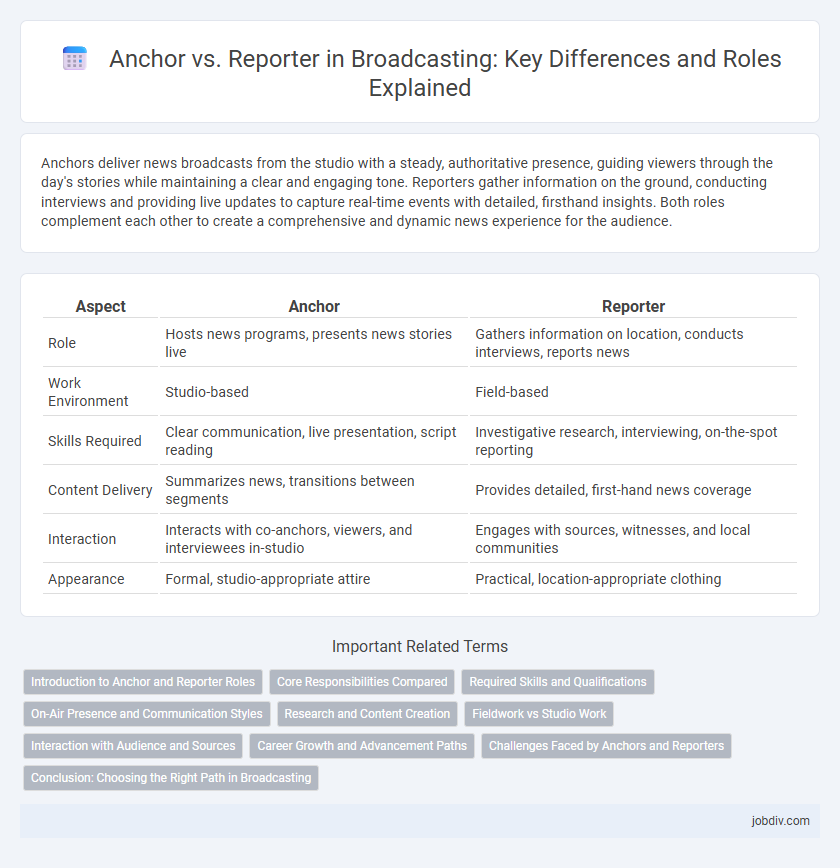Anchors deliver news broadcasts from the studio with a steady, authoritative presence, guiding viewers through the day's stories while maintaining a clear and engaging tone. Reporters gather information on the ground, conducting interviews and providing live updates to capture real-time events with detailed, firsthand insights. Both roles complement each other to create a comprehensive and dynamic news experience for the audience.
Table of Comparison
| Aspect | Anchor | Reporter |
|---|---|---|
| Role | Hosts news programs, presents news stories live | Gathers information on location, conducts interviews, reports news |
| Work Environment | Studio-based | Field-based |
| Skills Required | Clear communication, live presentation, script reading | Investigative research, interviewing, on-the-spot reporting |
| Content Delivery | Summarizes news, transitions between segments | Provides detailed, first-hand news coverage |
| Interaction | Interacts with co-anchors, viewers, and interviewees in-studio | Engages with sources, witnesses, and local communities |
| Appearance | Formal, studio-appropriate attire | Practical, location-appropriate clothing |
Introduction to Anchor and Reporter Roles
Anchors present news stories live on television or radio, guiding the broadcast and maintaining viewer engagement while ensuring accurate delivery of information. Reporters gather, investigate, and verify news stories on location, providing firsthand accounts and detailed coverage. Both roles are essential in broadcasting, with anchors serving as the program's face and reporters acting as the primary source of breaking news content.
Core Responsibilities Compared
Anchors primarily deliver news stories directly from the studio, maintaining a steady flow and engaging the audience with clarity and professionalism. Reporters gather firsthand information on location, conducting interviews, investigating events, and providing detailed, real-time updates. The anchor synthesizes and presents compiled reports, while the reporter acts as the primary source for raw, on-the-ground news content.
Required Skills and Qualifications
Anchors require strong verbal communication skills, on-camera presence, and the ability to read scripts fluently, often holding degrees in journalism or communications. Reporters need investigative skills, quick thinking, and proficiency in fieldwork, typically backed by experience in news gathering and interviewing techniques. Both roles demand adaptability, a clear understanding of current events, and the ability to meet tight deadlines in dynamic broadcasting environments.
On-Air Presence and Communication Styles
Anchors maintain a consistent on-air presence, delivering news with a composed, authoritative tone that builds viewer trust and anchors the broadcast's flow. Reporters exhibit dynamic communication styles tailored to live, on-location reporting, often conveying immediacy and emotional context to engage audiences. The anchor's controlled delivery contrasts with the reporter's adaptable, spontaneous style, both essential for effective news storytelling.
Research and Content Creation
Anchors rely heavily on researched scripts and verified data to present news clearly and authoritatively, ensuring consistent content delivery. Reporters engage in primary research by gathering firsthand information, conducting interviews, and capturing live events to create original, dynamic content. Both roles demand strong research skills, but reporters prioritize raw data collection while anchors focus on content synthesis and presentation.
Fieldwork vs Studio Work
Anchors primarily work in studio environments, delivering news with controlled lighting, teleprompters, and polished visuals, ensuring a consistent and professional broadcast. Reporters engage in fieldwork, gathering firsthand information, conducting interviews, and capturing live events under dynamic and often unpredictable conditions. The distinction impacts the skills required: anchors emphasize presentation and script-reading, while reporters rely on adaptability and direct audience engagement from diverse locations.
Interaction with Audience and Sources
Anchors primarily interact with the audience by delivering news directly from the studio with a composed and authoritative presence, creating a consistent and trustworthy connection. Reporters engage dynamically with sources on the ground, gathering firsthand information through interviews and live updates, which adds depth and immediacy to the broadcast. This interplay between anchor and reporter enhances credibility and keeps viewers informed with both polished delivery and real-time reporting.
Career Growth and Advancement Paths
Anchors typically experience career growth through increased visibility, leading to prime-time hosting and editorial roles, while reporters advance by specializing in investigative journalism or field reporting expertise. Anchors often transition into executive positions such as news directors or producers, leveraging their on-camera experience and network connections. Reporters build reputations by breaking significant stories, which can open pathways to anchor roles or subject-matter expert positions within broadcasting.
Challenges Faced by Anchors and Reporters
Anchors face the challenge of maintaining composure and delivering live broadcasts smoothly despite unexpected technical issues or breaking news. Reporters often encounter difficulties in gathering accurate information quickly while navigating unpredictable environments and ensuring personal safety. Both roles demand adaptability, clear communication, and the ability to think critically under pressure to provide reliable news coverage.
Conclusion: Choosing the Right Path in Broadcasting
Anchors serve as the central figures who present news with authority and consistency, while reporters gather detailed information and provide on-the-ground coverage, making each role essential for comprehensive broadcasting. Selecting between becoming an anchor or a reporter depends on strengths in live presentation versus investigative journalism and storytelling skills. Understanding these distinctions ensures a fulfilling career tailored to individual talents and industry demands in broadcasting.
Anchor vs Reporter Infographic

 jobdiv.com
jobdiv.com